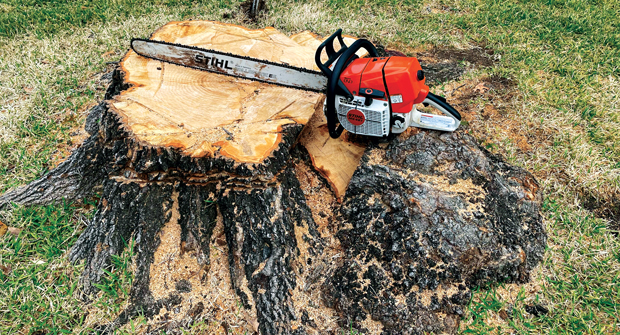
Landscape professionals need to plan ahead for tree stump removals to ensure they have the right bid, tools and safety measures in place.
Proper equipment
Before starting on a stump removal project, operators should first ask customers what they plan to do with the site once the stump is gone, says Joseph Demkovich, director of franchise operations and safety at Monster Tree Service in Doylestown, Pa. That information helps determine how deep the grinding needs to be and the pricing for the removal.
“If the site is going to be turned into a lawn area or the stump is in a mulched landscape bed, then a shallow grind maybe just fine,” Demkovich says. “But if another tree is going to be planted in or around the same spot, a deeper grind with some root chasing may be needed.”
Monster Tree Service provides tree removal, tree pruning, stump grinding, tree cabling/bracing and plant health care services for 90 percent residential and 10 percent commercial clients.
Demkovich says crews must also call 811 to locate and mark any utilities prior to the project. Once on site, they need to remove any loose dirt and rocks with a dirt rake or shovel. Teams also should use a well-maintained professional stump grinder with grinder teeth inspected for excessive wear, though starting a job with new teeth is best, Demkovich says.
Other important tools include a dirt rake, scoop or dirt shovel, wheelbarrow and a protective shield put around the stump to stop the debris from hitting someone. Contractors must also follow the American National Standards Institute (ANSI) Z133 safety standards and adhere to the stump grinder’s maintenance schedule.
Required personal protective equipment (PPE) for stump grinding includes industry-specific clothing, footwear, hard hat or helmet, safety glasses, face shield and hearing protection approved by ANSI, Demkovich says.
Come prepared
The stump’s size is a main determining factor for the type of approach needed prior to grinding, whether it’s a stump that needs digging up or one that requires a contractor to rent a stump grinder to remove, says Jeremy Lowe, director of agronomy at Chorbie in Frisco, Texas.
“We’d prefer to schedule that type of work together so we can have three to five stumps at one time to grind and take the crew out to those over the day,” Lowe says. “It’s a lot more efficient and saves the customers money by taking that approach.”
Chorbie provides landscaping, lawn care, pools, design/build, tree and shrub care, pest control and general handiwork services to mainly residential properties. Many of the removals they do are for volunteer trees — unwanted tree seedlings, so they first inspect the site to determine if it’s safe and accessible.
A Chorbie arborist or qualified professional walks the site prior to starting to note trip hazards, unlevel ground or anything they need to know about the safety of the job. They take photos and videos to better orientate the team before starting the project.
“If it’s not safe, we won’t do it,” Lowe says. “Don’t be afraid to walk away from an unsafe job.”
Mistakes to avoid
To prevent injury or damage, operators should steer clear of common pitfalls. Backfill holes with the stump grindings to prevent trip/fall hazards and to leave the area neat and clean, Demkovich says.
Wheeled grinders usually have removable dual wheels in the front for stability or uneven ground. Contractors may remove the wheels so the unit can go through gates, but must replace them before grinding, Demkovich says.
“If they are not replaced back on the machine, the risk of the machine tipping over is greatly increased — possibly causing serious injury to the operator,” Demkovich says. “Make sure the crew has the proper tools to remove and replace these wheels.”

